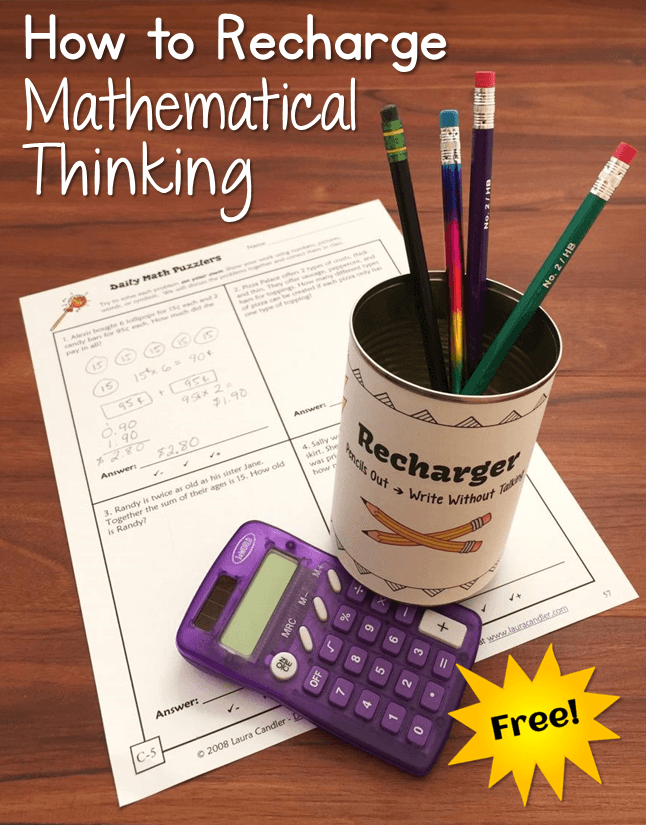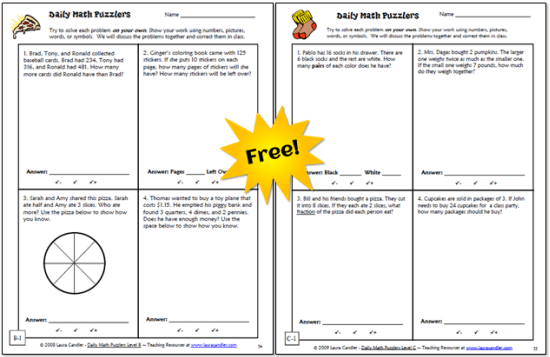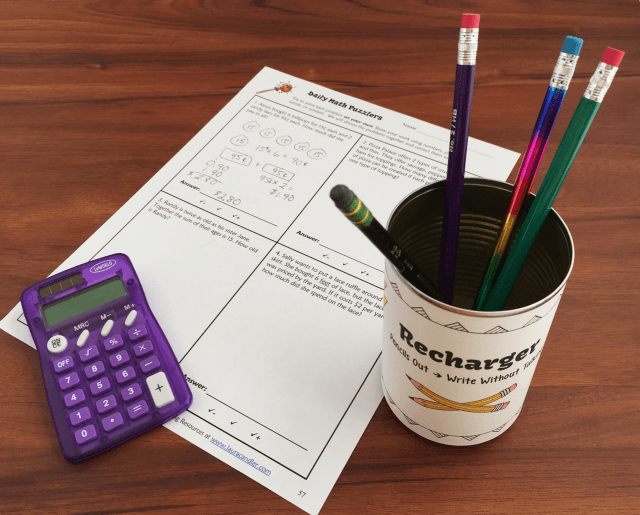 Why do so many students struggle with math word problems? Maybe they just don’t know where to begin and get overwhelmed at the thought of tackling math problems. Often students lack experience with different types of problems and the strategies for solving them, so they feel defeated and give up before they get started.
Why do so many students struggle with math word problems? Maybe they just don’t know where to begin and get overwhelmed at the thought of tackling math problems. Often students lack experience with different types of problems and the strategies for solving them, so they feel defeated and give up before they get started.
What can we do to help our students overcome their word problem phobias? One strategy that worked for me was to give my students opportunities to talk over how they planned to solve word problems before I let them pick up their pencils to work on them. Not just once or twice, but over and over until they were able to build confidence as problem solvers. At first, some of my students didn’t participate actively in those discussions. But eventually they jumped in with their own strategies, and they were so excited when their methods worked!
If you’re skeptical, you might be thinking about discussions you’ve observed in the past. Often one student does all the problem solving, and everyone else writes down his or her answer. But these discussions don’t really qualify as cooperative learning because group members are not participating equally.
To address this situation, I developed a strategy called Recharge & Write to encourage active participation and provide accountability. The basic concept is that students alternate between team discussion and independent written response. They first discuss each problem as a group, but when it’s time to solve the problem and write their answers, they aren’t allowed to talk. This strategy ensures that they will become active participants in the problem-solving process rather than letting others do their thinking for them. I recorded this short video to show you how it works. Click here to download the free directions and “recharger” label shown in the video.
This strategy is easy to implement, but you’ll need to do a little advanced prep the first time you use it. Recharge & Write has two important components: a “Recharger” (pencil holder) for each team and a math problem solving worksheet for every student. Read on to find out how these two components work together to provide structure and accountability.
Each team needs a cup or can (the Recharger) to hold their pencils during the team discussions. When students are ready to write their answers, they take their pencils out of the Recharger and write without talking. The beauty of this method is that it keeps everyone honest and controls the flow of the activity. Pencils In = Talk It Over. Pencils Out = Write Without Talking. Simple!
If your students ask why the pencil holder is called a “recharger,” explain that when the pencils are in the holder, your students are recharging their mathematical thinking by discussing how to solve each problem! To make a fun recharger out of a can like the one shown in the photo above, use this free label that’s included in the Recharge & Write freebie. Wrap it around a clean can and secure it with tape or glue.
The other necessary element is a worksheet that has just three or four word problems and provides plenty of space to solve each problem and to illustrate the answers. It’s essential that students show how they solve each problem. You can create your own worksheets, or use math word problem worksheets from the one of the books in the Daily Math Puzzler series. The worksheets are divided into quadrants, and each section has one word problem, a line for the answer, and space to illustrate or explain the solution. Download these free samples from the bottom of the Daily Math Puzzler page.
 How to Introduce Recharge & Write
How to Introduce Recharge & WriteBefore you introduce this activity to your students, seat them in teams of three or four and place a Recharger in the center of each team. Give the students on each team a copy of the same problem solving worksheet. (Note: If your students differ greatly in ability, be sure to read my suggestions for differentiating instruction below). Ask each team to choose the first Leader or appoint the Leader yourself. Display the Recharge & Write directions and walk your class through the process, allowing time for discussion and writing. Remind them that they may only discuss the problem when all pencils are in the cup, and they should not solve the problem and reveal the answer in that step. After they pick up their pencils to work out the problem, they may not discuss the problem further unless all pencils go back in the cup.
Management Tip –At first you may want to serve as the Leader and guide the whole class through the activity, stopping to allow time for discussion and writing. As your students are discussing the problems or writing, you can walk around and monitor their progress. Be on the alert for students who try to work ahead on problems before the rest of the team is ready. This is a natural error because most students are not used to this stop-and-start method of cooperative problem solving. Just remind them to follow the directions as described.

Should you let your students use calculators during this activity? That might depend on whether or not your students will be expected to use them on state tests. If you do allow them to use calculators, be vigilant when requiring them to show HOW they solved each problem, preferably by illustrating the strategy in some way.
Most cooperative learning activities are just for practice and really shouldn’t be graded. In most cases you don’t know whether everyone who participated understands the skill being practiced. However, Recharge & Write is a little different as long as you enforce the “no talking while writing” rule. After the discussion stage is over, everyone has to solve the problem independently and show their work, so I think it’s fair to grade their work. Let your students know in advance if you plan to grade the assignment, and you may want to use a rubric that includes points for effort and participation.
If you have students performing on vastly different levels, you can imagine what will happen if you put them together on one team. The students who struggle in math are going to be extremely frustrated, and the advanced students will be bored. This is a recipe for hurt feelings and off-task behavior. To solve this problem, reseat your students for this activity and place them in teams of students with similar ability levels. Give each team a different worksheet based on their needs.
The four leveled books in the Daily Math Puzzler series can make it really easy to differentiate Recharge & Write. The books are leveled from A to D, and the problems range from about 3rd grade to 6th grade. You can preview each product to see the problems for yourself, or you can use my free Problem Solving Assessment pack to help you determine the right level for each student.
Allowing your students to discuss math problems before solving them will definitely recharge their mathematical thinking and help them become more confident problem solvers. There’s no doubt that students benefit greatly from hearing how others tackle different types of problems. However, as soon as your students develop a little confidence, it’s important to have them solve word problems independently from time to time. Guess what resource can help with this too? 🙂 You guessed it! The Daily Math Puzzler program is versatile enough to be used for both cooperative learning AND independent problem solving!
I hope this strategy will recharge mathematical thinking in your classroom!